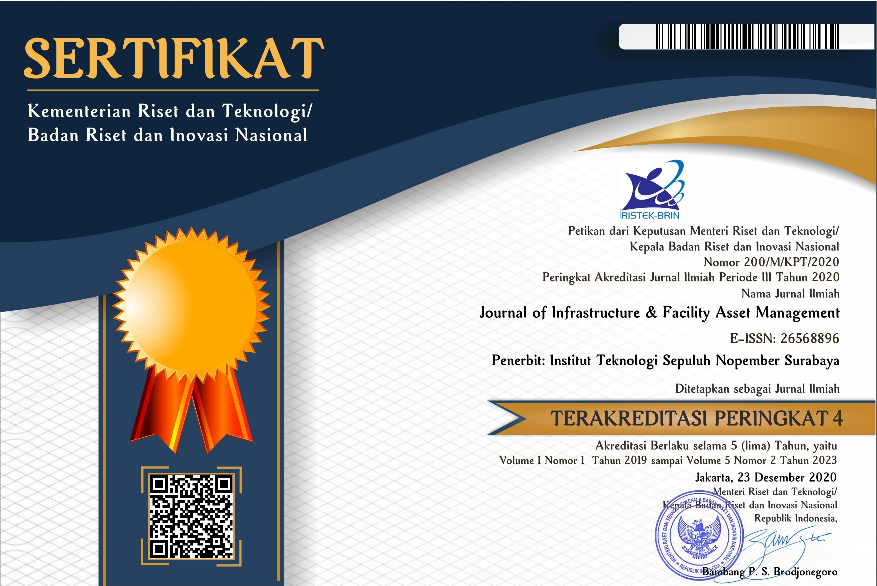Weighting The Fire Protection Systems Technical Requirements to Determine Flats Reliability Against Fire Hazards
Abstract
Flats are multi-story buildings built to serve a region that is divided into functionally structured sections, both in horizontal and vertical directions consist of each unit that can be owned and used separately. Flats are often identified as poorly maintained buildings especially in infrastructure and facilities that support the security, convenience, and safety of occupants and buildings. Fire in flats can be caused by various things including human, natural, and accidental factors. Fire prevention can be performed properly when flats manager and occupants can understand the risks that can trigger fires as well as those that can hinder the rescue process. This study tries to find out the weight of fire protection systems technical requirements to determine flats’ reliability against fire hazards based on the Minister of Public Works Regulation, National Fire Protection Association, and American Society For Testing and Materials. Through the filtering phase analyzed with Relative Importance Index followed by weighting phase analyzed with Pairwise Comparison, the result obtained an order of requirements from the highest to lowest weight are Means of Escape (24,1%), Active Protection Systems (18,9%), Passive Protection Systems (14,5%), Utilities (13,5%), Site Planning (10,1%), Occupancies (9,8%) and Housekeeping (9,1%).
Full Text:
PDFReferences
ASTM E931/94. American Standard Test Material Fire Test: E 931 – 9, Standard Practice for Classification of Occupancies for Their Relative Fire Hazard.
Direktorat Rumah Susun (2020), Laporan Kinerja Direktorat Rumah Susun T.A 2019, Direktorat Jenderal Penyediaan Perumahan, Jakarta.
Hardjomuljadi, S. (2014), “Factor Analysis on Causal of Construction Claims and Disputes in Indonesia (concerning the construction of hydroelectric power project in Indonesia)”. International Journal of Applied Engineering Research, Volume 9.
Irdayani dan Hardjomuljadi, S. (2016), “Kendala Proyek Konstruksi Yang Dikerjakan Secara Swakelola Di Kabupaten Pinrang”. Jurnal Konstruksia, Vol. 8, No. 1, Desember 2016.
NFPA 13/07. National Fire Protection Association, Standard for the Installation of Sprinkler Systems, 2007 Edition.
PerMen PU 26/08. Peraturan Menteri Pekerjaan Umum Nomor 26/PRT/M/2008 tentang Persyaratan Teknis Sistem Proteksi Kebakaran Pada Bangunan Gedung dan Lingkungan.
Sari, K.J. (2007). Evaluasi Sistem Pencegahan Dan Penanggulangan Kebakaran Pada Gedung Fakultas Ilmu Keperawatan Universitas Indonesia Kampus Depok, Tahun 2007. Skripsi. Program Sarjana Kesehatan Masyarakat Peminatan Keselamatan dan Kesehatan Kerja. Fakultas Kesehatan Masyarakat. Universitas Indonesia. Depok.
Seftyarizki, D., Ramawangsa, P.A., & Saputri D.O. (2019). ”Evaluasi Jalur Evakuasi Bencana Kebakaran Pada Sirkulasi Gedung Serbaguna UNIB”. Jurnal Manajemen Aset Infrastruktur & Fasilitas, Vol. 3, Edisi Khusus 1, Maret 2019.
Sugiyono. (2011), Metode Penelitian Kuantitatif, Kualitatif dan R&D, Penerbit Afabeta, Bandung.
Suprayitno, H. & Soemitro R.A.A. (2018), “Preliminary Reflexion on Basic Principle of Infrastructure Asset Management”. Jurnal Manajemen Aset Infrastruktur & Fasilitas, Vol. 2, No. 1, Maret 2018.
Suprayitno, H., Soemitro R.A.A., Maulana, A.M., & Hesna, Y. (2020), “Preliminary Reflection on Performance Indicator and Performance Factor for Infrastructure Asset Management”. Journal of Infrastructure & Facility Asset Management, Vol. 2, No. 1, March 2020.
Triyono, A. (2001). ”Teknik Penanggulangan Bahaya Kebakaran Di Perusahaan”.Majalah Hiperkes Dan Keselamatan Kerja, vol. XXXIV, No. 3, hal 34. Depnaker: Jakarta.
UU 28/2002. Undang – undang Nomor 28 Tahun 2002 tentang Bangunan Gedung.
DOI: http://dx.doi.org/10.12962%2Fjifam.v3i1.13464
Refbacks
- There are currently no refbacks.
Visitor :
Flag Counter

Journal Of Infrastructure & Facility Asset Management by Institut Teknologi Sepuluh Nopember is licensed under a Creative Commons Attribution-ShareAlike 4.0 International License.





